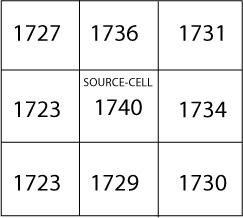Labs ERODE: Difference between revisions
| Line 17: | Line 17: | ||
Assume you have a 3 by 3 grid. So if one has a source cell of interest in the middle, we assume that water and sediment drains in the direction of the steepest slope. This concept is also called ‘steepest descent’. The grid cell in the middle then has 8 neighboring cells, and depending on their elevations (z), and the distance between the cells, d, you can calculate the slope, S. These surrounding cells are coded as shown in the figure here: <br><br> | Assume you have a 3 by 3 grid. So if one has a source cell of interest in the middle, we assume that water and sediment drains in the direction of the steepest slope. This concept is also called ‘steepest descent’. The grid cell in the middle then has 8 neighboring cells, and depending on their elevations (z), and the distance between the cells, d, you can calculate the slope, S. These surrounding cells are coded as shown in the figure here: <br><br> | ||
[[File:codingD8.jpg|300px]] | [[File:codingD8.jpg|300px]] | ||
<br> | |||
Question 3.1 | |||
In the hypothetical elevation grid below, the source cell and its 8 neighbours have defined elevation values. | |||
Where does the water drain to? Select the correct cell and list its D8- grid value. | |||
<br> | |||
[[File:test_exampleD8.jpg]] | |||
Revision as of 12:53, 25 February 2013
Landscape Evolution Modeling with ERODE
This lab introduces you to the landscape evolution model ERODE. ERODE is a raster-based landscape evolution model; it evolves a landscape with a combination of hilslope erosion and transport and river channel erosion and transport.
STEP1 Load the ERODE project
Once you are in the CSDMS Modeling Tool:
>> Under the File Menu, choose ‘Open Project’.
>> Go to the Terrestrial Group. Open Project: ERODE
>> Drag the ERODEGlobal component in the driver palette
>> Specify a unique working directory for each experiment, for example: /CMT_Output/ERODEexp1 (…etc for the next experiment).
Learn about Flow Routing with ERODE
An important part of ERODE is the way it treats routing of water (and sediment) through the landscape. To give you a bit of a feel of the methodology, we will look at the ‘D8 method’ for determining the drainage directions in a raster grid.
Assume you have a 3 by 3 grid. So if one has a source cell of interest in the middle, we assume that water and sediment drains in the direction of the steepest slope. This concept is also called ‘steepest descent’. The grid cell in the middle then has 8 neighboring cells, and depending on their elevations (z), and the distance between the cells, d, you can calculate the slope, S. These surrounding cells are coded as shown in the figure here:

Question 3.1 In the hypothetical elevation grid below, the source cell and its 8 neighbours have defined elevation values. Where does the water drain to? Select the correct cell and list its D8- grid value.

